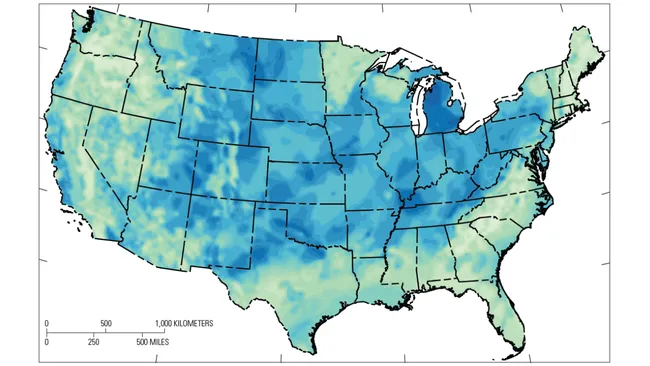
The U.S. Geological Survey (USGS) has released a groundbreaking map showcasing potential locations for naturally occurring hydrogen gas reserves across the contiguous United States.
This discovery has the potential to revolutionize the energy sector by identifying vast stores of this clean energy source beneath American soil.
>> RELATED: USGS Releases First-ever Map of Potential for Geologic Hydrogen in U.S.

A map depicting regions in the U.S. with low potential for hydrogen reserves (white to light blue) and areas with high potential (blue to dark blue). (Image credit: U.S. Geological Survey)
A Breakthrough in Hydrogen Mapping
The interactive map, available on the USGS website, marks a critical step in understanding geologic hydrogen, often referred to as “gold” hydrogen.
It identifies regions where hydrogen gas may exist in large, extractable quantities, challenging the previous belief that naturally occurring hydrogen reserves were too sparse for practical use.
Hydrogen gas forms underground through natural chemical reactions, often involving the splitting of water molecules into hydrogen and oxygen.
According to the USGS, three conditions must align for these reserves to form: a reliable hydrogen source, porous reservoir rocks, and natural seals to trap the gas. Until recently, scientists assumed these conditions were rare, but this new map suggests otherwise.
“For decades, the conventional wisdom was that naturally occurring hydrogen did not accumulate in sufficient quantities to be used for energy purposes,” said Sarah Ryker, Associate Director for Energy and Mineral Resources at USGS. “This map is tantalizing because it shows that several parts of the U.S. could have a subsurface hydrogen resource after all.”
Where Are the Reserves?
The map reveals promising hydrogen prospects across at least 30 U.S. states. Key regions identified as highly prospective (marked in dark blue on the map) include:
- Michigan, which shows significant potential across most of the state.
- Eastern Kentucky and southern North Dakota, both marked as hotspots for exploration.
- Parts of Kansas, Colorado, Wyoming, Iowa, and Oklahoma.
Additional areas along the California coast and the Eastern Seaboard also exhibit potential, making hydrogen a geographically diverse resource in the U.S. Large swathes of the Midwest, in particular, appear to offer ideal geological conditions for hydrogen accumulation, further solidifying the region’s role as a future energy hub.

>> In Other News: Nel ASA: Receives Purchase Order for 5 MW of Containerized PEM Electrolysers
Hydrogen: The Energy of the Future?
Hydrogen is increasingly seen as a cornerstone of the clean energy transition, offering a sustainable alternative to fossil fuels.
According to the International Energy Agency (IEA), hydrogen demand is expected to grow fivefold by 2050, accounting for up to 30% of the energy supply in certain sectors, such as transportation and heavy industry.
To put its potential into perspective, a 2023 study estimated Earth’s total buried hydrogen reserves at 6.2 trillion tons (5.6 trillion metric tons).
If just 2% of that reserve were tapped, it could power the entire world’s energy needs for 200 years. However, identifying reserves that are both accessible and extractable is critical.
“In the previous study, we showed there is a significant potential for geologic hydrogen as an emerging energy resource,” said Sarah Gelman, a geologist at the USGS Central Energy Resources Science Center. “The logical next step was to find where it might be in the United States.”
What the Map Means for Exploration
The significance of the map goes beyond simply identifying where hydrogen may exist. It provides a foundation for future exploration and investment in cleaner energy solutions.
Developing the technology to safely and efficiently extract geologic hydrogen is now the focus of researchers and energy companies alike.
The map reveals a clear path for exploring domestic hydrogen resources, reducing dependence on imported energy.
Additionally, the accessibility of hydrogen reserves in multiple states could pave the way for more localized and resilient energy networks.
Hydrogen's environmental benefits are substantial. When burned or used in fuel cells, hydrogen produces zero carbon emissions, releasing only water as a byproduct. This makes it an ideal solution for meeting global climate goals while transitioning away from traditional fossil fuels.
Challenges and Opportunities Ahead
While the map offers exciting possibilities, there are still challenges to overcome. Extracting hydrogen from underground reserves requires advanced technologies, some of which are still in the early stages of development.
Additionally, researchers need to evaluate the economic and environmental feasibility of large-scale hydrogen production.
The potential rewards, however, are immense. The clean energy market is projected to grow to $1.4 trillion by 2030, according to BloombergNEF.
Hydrogen’s role in this market could expand dramatically as companies and governments invest in its development. Already, major energy firms and startups are eyeing geologic hydrogen as a game-changing resource.
The Road Ahead for Hydrogen Energy
The first-of-its-kind USGS map represents a major step forward in identifying domestic energy opportunities.
It highlights regions with high hydrogen potential and underscores the importance of investing in cleaner, more sustainable energy sources.
As exploration and technology advance, hydrogen could become a cornerstone of the U.S. energy strategy.
Could hydrogen reserves lurking beneath the surface be the key to achieving energy independence and sustainability? With this new map, researchers are one step closer to finding out.
Subscribe to the newsletter
Daily decarbonization data and news delivered to your inbox
Follow the money flow of climate, technology, and energy investments to uncover new opportunities and jobs.
Latest issues
-
The Three-Continent Move That Redefines SAF
Wishing everyone a restful holiday season.🎄🎅🎁 Inside this Issue ✈️ Cathay Goes Global With SAF in Three-Continent Fuel Deal 🧪 Proton Ventures Partners With Barents Blue For Realization Of The Bar...
-
Can One Truck Fix Hydrogen’s Biggest Problem?
Inside This Issue 🚛 Alberta's Shared Truck Model Could Crack Hydrogen Adoption ✈️ ZeroAvia Completes Financing Round 🌾 Frontier And NULIFE Scale New Biowaste Carbon Removal Approach 🔥 WAGABOX® Of ...
-
North America’s Carbon Removal Year in Review: Winners, Losers, Surprises
Inside This Issue 🌎 North America's Carbon Removal Year in Review: The Deals, Policies, and Milestones That Shaped 2025 🚢 Hapag-Lloyd And North Sea Container Line Win ZEMBA Second E-Fuel Tender 🪨 ...
Company Announcements
-
ClimeFi Announces New 85,000 Tonne Procurement Round
In its latest procurement round, ClimeFi has enabled more than US$18m in durable carbon removal purchases across eight removal pathways: Biochar, Bioenergy with Carbon Capture and Storage (BECCS), ...
-
Vallourec, a world leader in premium seamless tubular solutions, and Geostock, a global specialist in underground storage of energy, have signed a Memorandum of Understanding (MoU) to strengthen th...
-
CMA CGM, DHL Step Up Ocean Freight Decarbonization with Biofuel Deal
DHL Global Forwarding and shipping group CMA CGM have agreed to jointly use 8,990 metric tons of second-generation biofuel to reduce emissions from ocean freight. The initiative is expected to cut...
-
Next-Generation Gas Turbine Control System For Thermal Power Plants Completes Functional Testing
Integration of Mitsubishi Power's control technology with Mitsubishi Electric's high-speed data processing technology Supports rapid load adjustments and diverse fuels including hydrogen Tokyo, ...